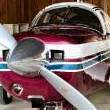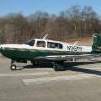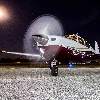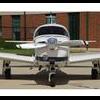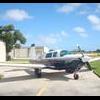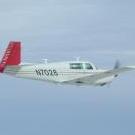Leaderboard
Popular Content
Showing content with the highest reputation on 09/19/2024 in all areas
-
This is going on my Santa wish list this year. Pro tip - grab your wife’s phone, open instagram and say what you want to buy 3x. Do this daily for a week and her feed will be nothing but what you want. I'm batting 1000 and she thinks she’s crushing Christmas!5 points
-
Finally a small update… found one bad plug - figured we were on to something. But still a vibration. Compressions are all good, plugs are all tested/good. Both magnetos checked. Magneto timing checked. Prop was dynamically balanced 2 months ago. We dug through log books and we found the Lord motor mounts are 32years old. They don’t have tons of hours but 32 years is a long time if the logs are right. Motor is not sagging, mounts look ok visually and are squishy still. Bottom mounts maybe look a smidge sagged. We decided to do motor mounts. It’s good maintenance no matter what. I’m curious what we learn, I will continue to post. I spoke to a 30-year vibration expert, he told me any mounts beyond 10-15 years can easily equate to doubling the vibration. He went through all details with me and agreed mounts are next on the list. I’ll continue to post as we learn more…5 points
-
That doesn't look bad. You already have the upgraded steering horn. You are moving the rudder linkage a little, so it isn't all slop. After 40 years of steering horn ownership and maintenance, I would wait till it gets real annoying while taxiing, or you are just wasting money. After it gets annoying, you can shim it up and get a few more hours out of it. When you have to shim it too often, then buy a new one. It is always the shaft the horn rotates around when it retracts. It seems it should have a steel bushing there, but they didn't ask me during the design meetings.4 points
-
Reticule by all the other pilots. More so if the RSU had to fire a flare. A class mate made the base gear call on his first solo. It was a bit compromised by the sound of the gear horn. His instructor wanted to fire a flare. But the student became known as Beep Beep.4 points
-
I'm another F owner that really wanted a "J" bar but ended up with electric gear (the one I bought checked all the other boxes and was priced right). After nearly 7 years of ownership I've learned to trust it I make sure to perform the gear box maintenance every 100 and 200 hours per the SB. I think pretty much every other make and model of RG aircraft have powered landing gear...every time I see the $hit show of a Cessna single retracting its gear I breathe a sigh of relief I have Mooney electric gear! So, no, don't make electric gear a deal breaker, IMHO.3 points
-
Premier Aircraft Engines is at Troutdale. You could have them look at it. My guess would be that the cylinder wasn’t overhauled correctly. I’d try to have Greg source another overhauled cylinder.3 points
-
I have often wondered if tenting the whole plane with a giant tarp and putting the dehumidifier inside would be effective.3 points
-
I have a story on this. On my recent flight from Adak to Sapporro Japan, the same thing happened while pre-flighting in Adak. I sumped the port wing, continued my walk around and noticed a large pool of liquid under the plane as I was busy on the starboard side. Walked backed and the valve was leaking at a strong pee-level. Almost had a heart attack as I had 1900nm to fly with no option for more fuel as I'd shipped my two drums of AvGas to Adak at great expense months ago and there weren't any more for a 1000 miles. Got the leak to stop by working the valve, just as mentioned here. Took off for Japan. But now you're in the air with 14 hours to go. And of course you start thinking - what if that leak came back. Like the OP here describes.......... I swear I probably stared at that left tank fuel gauge for two hours non-stop before I convinced myself it's probably fine. (it was).3 points
-
I think it is a little of both. Some owners I know have a hard time accepting that the manufacturers TBO isn't because of extensive testing that shows it will die soon afterwards. I also think flight schools flying the planes very often eliminate so many issues that are caused by inactivity. As many here have said, it is better to buy a plane that has been flown often than one that has been sitting.2 points
-
Nothing happens. If you're maintaining it and it's running fine and passing inspection then nothing happens. Flight schools often get 3000 hours out of Lycoming four cylinders.2 points
-
You are absolutely correct I did say that, my bad. However, when the wind is zero, groundspeed = airspeed.2 points
-
I didn't. On a zero-wind morning take-off, observing it alerted me to the fact that something was off so I checked the pitot tube and had it cleaned out. Once that was done since I was only a month away from my pitot static check I had the avionics shop re-certify. I was highlighting the benefit of comparing the two airspeeds, nowhere did I advocate using a portable device to calibrate a certified device.2 points
-
I mean @N201MKTurbo rich answered it well, but once it’s on jacks, you can hold the nosewheel straight while wiggling the linkage to see exactly where it’s coming from. Mine would “wander” a bit while taxiing and the new bolt/shim was back ordered (I did finally get it) so my IA shimmed it and it’s so much better. There are lots of rod ends, bolts, shims that can affect it, so make sure it’s nailed down before throwing parts at it (or wait until it’s worse). Now that I think about it, I think we actually held the linkage still while wiggling the nose gear (up on jacks) to see where the loose parts were.2 points
-
I got my D3 about 2-1/2 years ago and mounted it on the compass post shortly after buying the airplane. Not the greatest picture but you get the idea. - - - Buying the D3 and comparing the airspeed to my primary airspeed indicator carried an unexpected benefit. My pitot tube had a partial blockage and my ship’s airspeed indicator was reading about 10 kts low. This solved the mystery of why it wanted to come off the ground about 10 knots early on take-off . . Lol Sent from my iPhone using Tapatalk2 points
-
I'm an engineer with two degrees that say so, and for a short period was also lame. But two months of physical therapy got me moving properly again. Sorry, no, I work(ed) in manufacturing, not on airplanes . . . .2 points
-
There's no adjustment for track and it's not an inspection item. The K model SMM says the track is 9' 2" (110") in the data and then on the drawing shows 9' 3/4" (108 3/4"). It doesn't specify exactly what to measure, either (center to center?), but I get the impression there's no intention for it to be a precision thing. The only real adjustments on the main gear are for the downlock preloads to prevent gear collapse. There is no procedure in the SMM to adjust track. I don't know what he might be looking at, as I don't know of anything that needs to be adjusted to 59" related to the gear. All of the measurements in the gear rigging process, even starting from scratch, are small (either thousandths or a couple inches) and relative to positions of the control rods, springs, etc. He might be worried that there's a bearing or bushing failed somewhere, but that could be assessed with a gear swing. It might be worth clarifying what's up.2 points
-
Be sure to use "close tolerance" bolts when you reassemble. NOT just ordinary AN bolts IF you had play in the tail in excess of the small amount allowed be sure it was not just from using regular AN bolts! I have found a couple of airplanes out of tolerance for the wiggle and it turned out they had plain AN bolts in the hinge bushings instead of the required "close tolerance" bolts.2 points
-
According to the Precision Airmotive RSA operation and service manual, the most common inlet screen filters down to 74 microns. An average human hair diameter is about 100 microns. When examining and cleaning these, remember that the screen filters from the inside out so debris will be inside the screen.2 points
-
A good thing to do is just fly to a reasonable altitude once in a while. It'll push most of the air out of the various spaces and inhale dry, high-altitude air as you descend. Dries it out nicely.2 points
-
I put a cheap, Amazon dehumidifier hanging from the coat rack in my plane. The outlet tube runs into the tailcone and hangs above the opening for the retractable step. I just leave the tubing in place and connect the dehumidifier when I put the plane up. My hangar leaks through the roof and during periods of high rain volume water comes in under the walls and remains standing on the hangar floor for a few days. But I don't have any other hangar options and my cost is $60/month. The humidity in south Louisiana is 99% year-round. The dehumidified air inside the plane gets as low as 30%. I don't do anything for the wings/ fuselage. -David2 points
-
Plus you get alot more performance from the O than the J. Even more with the STC and 310 HP. I can true 172-174 KTAS at 12-14k at 11.5 GPH or so.1 point
-
More practically, a lot more useful load and cargo space. Plus, for my standard 600 nm family trip, shaving 30 minutes with the 20 knots speed increase brings more family harmony. If fuel economy is your primary goal, the J (or cleaned up E or F) is the optimum. If you need more speed and more cargo volume, you look to the long bodies at the expense of economy.1 point
-
As long as your IA signs offs on your Annual then your plane is Airworthy. Airworthy is Airworthy - regardless of 2,500 hours on your engine or only 100 hours. Some would argue that a newly broken in engine is a higher risk than one near TBO due to infant mortality. However, people have posted here that a buyer cannot get financing on a plane with an engine over book TBO. I don't know if that is true in all cases.1 point
-
In addition to engine hours, TBO also includes calendar years, 12 yrs. is very common. You do not see anybody doing overhauls on time in service though1 point
-
I was surprised reading the manual that the D3 turns on any time it's connected to USB power, but now that I think of it as a (euphemistically) 'installed' instrument, it makes perfect sense. I also like that Dynon supplies a USB charger plug with 2 USB ports. One for the D3 and one for my iPad! Very complete package and a nice little safety backup for the price. QUESTION: For those who have experience with the D3, do you have to calibrate it every time you start it, or does it remember the previous calibration? An in a Mooney, is setting the horizon when on level ground close to level in flight attitude at cruise?1 point
-
I just bough bought a pound of 1 micron molybdenum disulphide powder and make my own. It doesn’t cost that much. Just wear old cloths when working with it. It doesn’t wash off. https://rosemill.com/product/molybdenum-disulfide-super-fine/?attribute_lb=1+lb&gad_source=1&gbraid=0AAAAAB2_hOjQG2U7P3eNpNln9OeUi_7qx&gclid=EAIaIQobChMIgpaNlvLPiAMVudHCBB27UiPPEAQYAiABEgKnUfD_BwE1 point
-
The F model "with all the J model speed mods" is truly a J. I have a 1968 F, Johnson Bar, Hydraulic flaps, long range tanks, turbo normalized, speed brakes, etc. etc.... 10,000 ft, 100 ROP, 75% power = 160kts 10,000 ft, 100 ROP, everything forward = 168 kts 17,000 ft, 100 ROM. 75% power = 175 - ? 180 kts Take a look at my profile.... The biggest speed change is with the 201 windshield and cowling. But it a lot of work. You will not come close to what you are looking for spending $100,000 is this market. I suspect you would be hard pressed to find a very nice turn key E or F for that amount. John Breda1 point
-
I bought four six gallon jugs and tanker fuel back when I go buy an area airport that has very reasonable fuel prices1 point
-
IMO JPI has the best engine monitoring products, and if/when I update to a big PFD I will retain my EDM-900 and keep it on the pilot side panel. YMMV of course. The 900 can fit just about anywhere on a Mooney panel which is why I chose it.1 point
-
Long term, my C runs ~9gph, less up high, less when shooting multiple approaches. But I have to run ROP due to I efficient distribution after the carburetor.1 point
-
Those are good fixes, but have nothing to do with the slop he is showing.1 point
-
I'm in the SF Bay area and 100LL fuel around the area runs from a low of $4.90 to a high of $11.35. Definitely worth shopping around.1 point
-
$4.98 at KCVC earlier today, I always tell folks that gas is the cheapest part of ownership.1 point
-
1 point
-
I have been flying Mooneys since 1990 and teaching in them since 1994 when I got my CFI. I've had my Bravo for 32 years. I've flown the E, M, R, TN, V across the US, with the M, R, being flown across more times than I can remember. I mean across being from Florida to California. The longest day with weather cooperating was a flight from Fort Lauderdale to Colorado Springs. It took over 10 hours in the Bravo. Of my nearly 13,000 hours, nearly 11,000 have been in Mooneys. So you can see I really love Mooneys. I say the above because, although I love the Mooney, it is NOT the right airplane for what you want to do. If you were to base it in Columbia and use it to fly around South America, maybe. A once in a lifetime trip? OK, but even then I would have considerations. In my opinion you really need a mid sized jet.1 point
-
1 point
-
I have given some thought to using a system similar to your idea for just the engine. By essentially "tenting" the engine area with a not-especially-tight seal around the cowl and where the tent meets the hangar floor, and then pumping enough dehumidified air into the tent to extract the moisture from every crevice of the engine. For the engine, this avoids reconditioning crystals, hooking things up to intake, exhaust, oil filler, etc. Similar to dehumidifying the hangar, but requires much less volume of dehumidified air. No reason it wouldn't work for other parts of the airplane. In fact, your idea might be easier to implement because the volumes you are proposing to dehumidify are already somewhat air tight. Maybe instead of blowing in one orifice (like the storm window) and drawing out air from another, you could just blow dehumidified air in, and let the moisture-laden air leak out of all the small exit points.1 point
-
Strongly suggest Aeromotors for overhaul. They make a number of modifications to the pump that improve its reliability and function a great deal. They’re also very reasonable. I think less than $500. They often have an exchange pump on the shelf, but if they don’t, turn around as fast.1 point
-
I always carry a spare fuel drain just in case this happens during pre-flight.1 point
-
Shot at with a red flare gun1 point
-
Gary was one of those larger than life characters and jokester. We flew to many of the monthly Florida Mooney lunches, and when I did they flying, he would be very critical, commenting on everything from cylinder head temperature to localizer deviation. He was very proud of his service in Vietnam and loved to share stories. In tribute to Gary, I advise all you guys to get a PSA test.1 point
-
Well actually, for certified aircraft, the FAA is the final authority. The FAA approves Mooney’s TC and the AFM and Garmin’s STC. Garmin would likely have flight test data to support 7 deg when applying for the STC.1 point
-
As in pure military. At least on the USAF side. At Martin State, when the A-10s are recovering, there is a truck with a qualified pilot at the approach end. They have a radio, binoculars and a loaded flare gun. You won't hear their gear down calls, as they are using UHF, not VHF. But they DO make the call. And the person in the truck double checks the configuration for gear and flaps. BTW, if doing a practice no flap, the call is Base, Gear Down, No Flap. If the configuration does not match what the pilot on the ground sees, they call a go around on the radio. If the pilot flying does not respond/react to the radio, they get a red flare fired.1 point
-
I toured a testing facility a month ago. They mostly did construction stuff, but they had all the tools to figure it out. They would section and polish a sample, then image it in a SEM, then do a spectral XRF analysis of the material and finally do a Rockwell hardness test at many points on the sample. The lady who did this could tell you exactly what the material was had how it was heat treated. She mostly inspected welds, but could do anything. She really knew her stuff. https://pnltest.com/1 point
-
Believe it or not but the FAA often doesn’t have a copy of all the drawings, the amount of drawings are enormous and of course they change often, so the man power and just plain storage space for an FAA MIDO to have a copy of all drawings would be pretty much impossible, and of course drawings changed often so someone would have to post every change for every drawing. Can you imagine for instance the FAA having all the drawings for every Gulfstream ever built and then to keep them current? Gulfstream is of course only one manufacturer that ATL MIDO manages. I assume it would fall under the MIDO, but it could be the ACO? Thrush was the only source of their drawings, if the FAA had a question about a part then of course Thrush would send them a copy of the drawings. Back two owners ago they got into a bad habit, if they wanted to change something they simply changed the drawings and didn’t seek FAA approval, how could they get caught? Well later on the Thrush QC head went to work at the FAA MIDO in Atl, and now the FAA keeps a copy of all current production aircraft for Thursh. I would hope that mooney if they had no interest in manufacturing the part would give a copy of the parts drawings. I know I used to. We tired to support all of our old aircraft but it just wasn’t possible for every part, in many cases the tooling for parts that hadn’t been built in 40 years didn’t exist and no one was still around who know how to build the thing, drawings often don’t tell you how to build the thing and there is a heck of a lot of what I call Tribal knowledge in building an airplane.1 point
-
You have bad information if you think the continental cannot make it to tbo. it most certainly can if operated properly.1 point
-
IPC MAN-203 for the 65-67 models shows the brace, whereas MAN-205 for the 68-76 models does not. So looks like they were deleted with the 1968 model year, though serial number is a better reference than "model year". Many folks aren't aware of the evolution of the cowling in the C/D/E/F models across the years. The stringers of the lower cowl in our airplane actually still have the mounting holes for the side braces, and I had one mechanic ask me where the "missing" side braces were, until I showed him the IPC applicable to our airframe.1 point
-
1 point
-
I had my magneto’s overhauled by Crossfire Magneto several years ago when it was located in Spruce Creek and run by Paul Bavard. Paul was a very knowledgeable person but he moved out of Spruce Creek (7FL6) a few years ago and I believe he sold the business.1 point
-
Don't have any knowledge of them, but have been very happy with Aero Accessories in Van Nuys, California: http://aeroacc-vny.com/1 point



